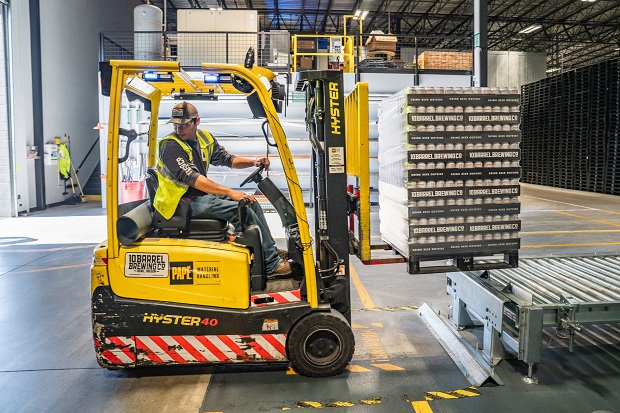Warehouse employees must adhere to a comprehensive set of health and safety rules, as warehousing entails a number of risks that, if not adequately managed, can result in severe injuries.

The Workplace (Health, Safety and Welfare) Regulations 1992 state that employers are responsible for implementing required steps to ensure a safe working environment for their employees. Having said that, warehouses are often chaotic environments, making it all too easy to overlook safety rules.
At the same time, overlooking safety rules is a major financial risk for employers since it can lead to litigation, inspections, fines and loss of reputation. Accidents can also cause property damage, require a great deal of paperwork and can result in having to shut down certain areas of the warehouse. Accidents and injuries can still happen even with proper training, but the risk is significantly reduced.
Warehousing is a market sector with more jobs than applicants. Younger generations are disinterested in long-term warehousing, while older generations are retiring, resulting in a shortage of skilled candidates for middle management. When it comes to entry-level jobs, the work can be physically taxing, and the wages are typically modest, which explains the high turnover rate. The shortage of warehouse workers has become even more pronounced now, with the pandemic prompting a rise in online shopping.
Warehouses are becoming increasingly crowded with inventory, yet there aren’t enough workers to keep up, resulting in dangerous working conditions. This is evident from the increased frequency of accidents and injuries.
Even when managed effectively and in a safe environment, warehousing is a demanding field of work. You spend a lot of time on your feet and doing a lot of bending and lifting. On top of that, there is significant variation in workload during the workweek and even throughout the workday. Then there are environmental variables like extreme temperatures, noise, and lighting, which might jeopardize the health and safety of workers.
Training
Employers are legally required to ensure that employees receive health and safety training before performing work-related activities such as operating warehouse equipment. The employer must also select a suitable and thorough training program.
Choose programs that cover issues relevant to all warehouse employees first, and then programs for specialized positions like forklift operator.
As the owner or manager, you will also have to go through health and safety training. Because management is held to a different standard than workers, your program will be more demanding.
You should already have safety protocols in place, such as requirements for new employee training and the safe use of warehouse equipment. However, as previously stated, during peak times, these rules are less strictly followed.
That is why you should develop a positive safety culture among your employees and urge them to report problems so that you can take action and prevent accidents from occurring.
Having CCTV surveillance systems installed can also be very useful during peak times because it allows for remote monitoring. Plus, it can help you negotiate lower insurance premiums.
Warehouse Equipment
The workers who use forklifts and other warehouse heavy equipment must be certified and follow safety procedures. Before operating the equipment, they must inspect it for any potential safety issues. Forklift safety precautions include wearing seatbelts, driving within the speed limit and avoiding driving in reverse.
Additional safety precautions can be implemented, such as one-way systems, route-planning, and the use of mirrors to improve visibility.
When approaching crosswalks, junctions, or busy areas in the warehouse, forklift operators must sound the horn to reduce the risk of injury to other workers. The warehouse plan must provide specified lanes and well-defined routes for forklifts. Adding bumpers to docks, columns, and racking further reduces the risk of damage.
All warehouse equipment must be inspected on a regular basis in compliance with applicable legislation and manufacturer recommendations.
Personal Protection Equipment (PPE)
You are required by law to give your employees personal protection equipment and training so they understand how to use and care for it. Staff must attend training sessions, wear equipment, and notify management if the PPE is damaged and in need of repair.
Personal protective equipment is available in a variety of options, so the management team must assess the risks and select the most appropriate ones. Hard hats are a common piece of PPE that must meet manufacturing standards. Be cautious about where you buy them because there are cheaper versions available that provide less protection.
Additionally, workers will require bright visibility jackets that aid in preventing forklift accidents. Anti-slip shoes help reduce the likelihood of slips and falls, while steel toe caps help protect employees from impact or crush injuries. They’ll also need safety glasses to keep debris out of their eyes. Finally, because warehouses can be quite noisy, hearing protection in the form of earplugs or ear defenders is sometimes needed.
Shelving and Racking
In a warehouse, the workers must unload items of different sizes, shapes and weights onto racking, either with the help of equipment or manually. They must know how to do it safely because it can result in injuries or property damage. To keep accidents and injuries to a minimum, have the shelves and racking inspected on a regular basis.
Employees must understand how to properly arrange things and distribute weight on shelves and racking. This includes the maximum safe weight that a rack or shelf can support. When your employees need to reach higher shelves, instruct them to use ladders or other appropriate equipment instead of pellets or forklifts.
Slips, Trips, and Falls
According to the Health and Safety Executive, slips and trips are the leading cause of work-related injuries in the United Kingdom.
To prevent slips, trips, and falls, you need to make sure that all employees understand proper housekeeping practices. They should clean up spills, clear paths of obstructions, tidy up cables, and so forth.
The cleaning staff needs to use appropriate warning signs, and cleaning should be scheduled outside of the usual work hours to reduce risk.
In addition to using the correct detergent for the warehouse floor, you can reduce the risk of slipping by using anti-slip paint, tape and shoes. The floors need to be even, so workers don’t lose their balance while carrying a load.
If you need to run cables over the floor, use heavy-duty cord covers. Covers not only prevent trips, but they also protect cables from being run over by vehicles.
Staff should be trained to work securely at heights. Ladder safety is especially important since using an unsteady ladder or misusing it can result in serious injury or even death.




Comments are closed.